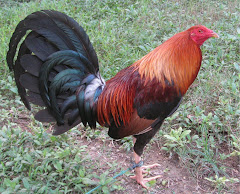
The rooster has long been respected
for its ferocity as a fighter
By Richard Blunt
The domestic chicken, or Gallus domesticus as the Romans called it, has lived with humans for centuries. It is probably the descendent of a wild asian bird, and historians have found references to its domestic descendant in the art and literature of India, China, and southeast Asia as early as 3000 BC. Egyptians were managing large flocks of chickens by the Second Dynasty (2890 to 2680 BC), but for some reason did not record much about their accomplishments in the breeding and keeping of chickens. Greek writings, however, describe how Egyptians designed and built clay incubators with the capacity to incubate and brood 10,000 to 15,000 chicks at a time. Incubators with greater capacity have only existed in this country and western Europe for about 80 years.
It was sometime before the sixth century BC that the Egyptians and the Persians introduced the wonders of domesticated chickens to the Greeks. The Persians shared their talent for breeding Malayan and Indian jungle fowl, which were used primarily for cock fighting, while the Egyptians taught the Greeks how to successfully develop and maintain breeds for the production of eggs and meat. For the next 200 years, chickens became an indispensable element in Greek life. At first they were used primarily in religious ceremonies, folk medicine, and the popular sport of cock fighting. But by the third century BC, breeding chickens for egg laying and meat production had become a priority in Greek civilization.
The Greeks passed their knowledge of the chicken on to the Romans. It was in Rome that the chicken truly reached its apotheosis. There, it became a sacred bird, often used as the central figure of various methods of divination, apothecary, and as a serious subject for philosophical inquiry. In Rome, fighting cocks were trained like gladiators. They were fed garlic before they fought in the belief that it would increase their courage and ferocity. The Romans also believed that garlic had the same effect on men. The writings of Roman naturalists and philosophers elevated the chicken to an exalted position in urban civilization. They skillfully molded it into a genuine object of scientific scrutiny and philosophical inquiry. No longer would the chicken be a taken-for-granted resident of the barnyard or cockpit.
The chicken has always meant much more to people than a cheap meal. The cock, or rooster as we now call it, has long been respected, especially for its ferocity as a fighter. In ancient Syria, Borneo, and Sumatra the fighting cock was worshiped as a god—an exalted status that usually saved it from becoming Sunday dinner. There was even a time in ancient Greece when cock fighting was considered a national sport. The Romans viewed the cock as a noble gladiator, and the cock fight was a solemn ceremony that reinforced their belief that men should be brave—imitators of the cock.
Cockfighting came to its greatest secular popularity and refinement in late medieval England. The Church made vigorous efforts to repress it but only succeeded in driving it underground. As a compromise with the people, the Church did finally sanction organized cockfighting events on special days, such as Shrove Tuesday. One very popular Shrove Tuesday event was held in English grammar schools. The schoolmasters were paid a “cock fee” for allowing the children to bring their cocks to school, and all learning was suspended for the day as the desks and chairs were pushed aside to make room for the daylong contests. The student who owned the champion cock was excused from corporal punishment during Lent, along with one other student of his choice. At the end of the day the school master was presented with all of the cocks that were killed.
During the reign of Henry VIII, cock fighting flourished in England, exceeding even horse racing in popularity. James I, Charles II, And William the III were among other monarchs who were avid cockers. By the end of the 18th century, however, reformist doctrine started to take hold with the English majority. By 1835, cock fighting was reduced to the rank of a cruel and capricious sport and was, once again, driven underground.
In spite of being prohibited in England, after 1835 cockfighting found a new home in America. Ships that carried English settlers to America also carried chickens and fighting cocks. Cock fighting was frowned upon by the Puritans but it still flourished from New York to Georgia. Before and after the Revolution, New York was the center of cockfighting in the East. Here the sport was dominated by freed slaves and Irish immigrants.
Before long, the sport spread west and became most popular in areas settled by Southerners and the Irish. As in England, reformers moved quickly to force legislation to outlaw cock fighting but it soon became obvious that there was little sentiment for this type legislation on the national level, so the individual states were left to pass there own laws. But even on the state level, very little anticocking legislation was passed until early in the 20th century. While visiting friends in Florida, in 1971, I was surprised to find that cockfighting was still legal in that state.
Outlawing cockfighting in this country has had the same effect as Prohibition. As you read these words somewhere in this country, loyal members of a tight fraternity of cockers is gathering around a pit, anxiously waiting to place their bets on the outcome of the main event.
Cultural influence
The chicken has influenced our languages and cultures. From ancient times to the present, if two people look or act the same, they are said to be “hatched from the same egg.” The ancient Greeks compared poor writing to “chicken scratches.” The proverb, “I would not have him count his chickens so soon before they hatched,” was found in a collection of proverbs published in 1579.Superstitions surrounding chickens are also alive and well in both urban and rural areas. One superstition declares that there will be sickness in the house if a hen crows. Another claims that a farmer's chickens will be like the first person who comes to his house on New Year's morning—a stout and prosperous person meant plump chickens while a poor meager person meant scrawny chickens.
Make a wish
Two people tugging on the magic clavicle, or wish bone, until it breaks, dates back almost 2,500 years to the ancient Etruscans. Chickens were kept in Etruscan temples to answer questions by pecking at corn kernels in a circle marked with letters of the alphabet. When the bird was through eating, a priest would enter the circle and interpret the results. When one of these sacred birds died, its collar bone was dried and believers were allowed to stroke it and make a wish. When the custom was passed to the Romans, people started tugging on the bone until it broke. The wish of the person holding the half containing the “head” would be granted. I've heard it suggested that the phrase, “to get a lucky break,” came from this ancient custom.
Before trained physicians came on the world scene in 18th century, chickens provided a living drug store of remedies for everyone—rich and poor. In the practice of folk medicine, people were inclined to reach for a chicken to cure almost any malady of the body or the spirit. In ancient Greece, as well as other parts of the world, fever, arthritis, colic, dysentery, epilepsy, headache, constipation, and cough were all treated with various parts of the chicken. The remedies are endless and most are far too complicated and absurd to mention here. But some made sense and are still used today: a bowl of homemade chicken soup has always been, and probably always will be, prescribed as a comfort and cure for many maladies, real and imagined.








